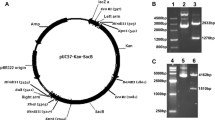Summary
Escherichia coli K803 cells were mutagenized and screened for the presence of clones sensitive to ψ-rays but not to ultraviolet light. One new mutant of this type, named rorB, was isolated. This mutant is both cross-sensitive to mitomycin C and shows reduced conjugal recombination frequencies, but to a lesser extent than the phenotypically similar mutant recN. Unlike previously reported mutants of E. coli or yeast with an enhanced sensitivity to ionising radiations, rorB appears to be near wild type in ability to rejoin DNA double-strand breaks. The rorB gene maps close to ilvGEDAC at 84.5 min of the E. coli chromosome.
Similar content being viewed by others
References
Blocher D, Pohlit W (1982) DNA double strand breaks in Ehrlich ascites tumour cells at low doses of X-rays. II. Can cell death be attributed to double strand breaks? Int J Radiat Biol 42:329–338
Bradley MO, Kohn KW (1979) X-ray induced DNA double strand break production and repair in mammalian cells as measured by neutral filter elution. Nucleic Acids Res 7:793–804
Breckenridge L, Gorini L (1970) Genetic analysis of streptomycin resistance in Escherichia coli. Genetics 65:9–25
Bryant PE (1984) Enzymatic restriction of mammalian cell DNA using PvuII and BamHI: evidence for the double strand break origin of chromosomal aberrations. Int J Radiat Biol 46:57–65
Budd M, Mortimer RK (1982) Repair of double strand breaks in a temperature conditional radiation-sensitive mutant of Saccharomyces cerevisiae. Mutat Res 103:19–24
Curtiss III R (1981) Gene transfer. In: Gerhardt P (ed) Manual of methods for general bacteriology. Washington, pp 243–265
Debenham PG, Webb MBT, Law J (1988) The cloning of the rorB gene of Escherichia coli. Mol Gen Genet 215:156–160
Frankenberg D, Frankenberg-Schwager M, Blocher D, Harbich R (1981) Evidence for DNA double strand breaks as the critical lesions in yeast cells irradiated with sparsely or densely ionizing radiation under oxic or anoxic conditions. Radiat Res 88:524–532
Frankenberg D, Goodhead DT, Frankenberg-Schwager M, Harbich R, Bance DA, Wilkinson RE (1986) Effectiveness of 1.5 keV aluminium K and 0.3 keV carbon K characteristic X-rays at inducing DNA double strand breaks in yeast cells. Int J Radiat Biol 50:727–741
Friedberg EC (1985) DNA Repair. Freeman, New York
Giaccia A, Weinstein R, Hu J, Stamato T (1985) Cell cycle-dependent repair of double strand DNA breaks in a γ-ray sensitive Chinese hamster cell. Somat Cell Mol Genet 11:485–491
Glickman BW, Zwenk H, Van Sluis EA, Rorsch A (1971) The isolation and characterisation of an X-ray sensitive ultraviolet-resistant mutant of Escherichia coli. Biochim Biophys Acta 254:144–154
Glover SW (1962) Valine-resistant mutants of Escherichia coli K12. Genet Res 3:448–450
Haas FL, Doudney CO (1957) A relation of nucleic acid synthesis to radiation-induced mutation frequency in bacteria. Proc Natl Acad Sci USA 43:871–883
Joshi GP, Nelson WJ, Revell SH, Shaw CA (1982) X-ray induced chromosome damage in live mammalian cells, and improved measurements of its effects on their colony-forming ability. Int J Radiat Biol 41:161–181
Kemp LM, Sedgwick SG, Jeggo PA (1984) X-ray sensitive mutants of Chinese hamster ovary cells defective in double strand break rejoining. Mutat Res 132:189–196
Krasin F, Hutchinson F (1981) Repair of DNA double-strand breaks in Escherichia coli cells requires synthesis of proteins that can be induced by UV light. Proc Natl Acad Sci USA 78:3450–3453
Natarajan AT, Obe G, van Zeeland AA, Palitti F, Meijers M, Verdegaal-Immerzeel EAM (1980) Molecular mechanisms in the production of chromosomal aberrations. Mutat Res 69:293–305
Park MH, Wong BB, Lusk JE (1976) Mutants in three genes affecting transport of magnesium in Escherichia coli: Genetics and physiology. J Bacteriol 126:1096–1103
Picksley SM, Attfield PV, Lloyd RG (1984) Repair of DNA double-strand breaks in Escherichia coli K12 requires a functional recN product. Mol Gen Genet 195:167–174
Resnick MA, Martin P (1976) Repair of double-strand breaks in the nuclear DNA of Saccharomyces cerevisiae and its genetic control. Mol Gen Genet 143:119–129
Russell RRB (1972) Mapping of a D-cycloserine resistance locus in Escherichia coli K12. J Bacteriol 111:622–624
Wood WB (1966) Host specificity of DNA produced by E. coli: Bacterial mutants affecting the restriction and modification of DNA. J Mol Biol 16:118–133
Author information
Authors and Affiliations
Additional information
Communicated by B.J. Kilbey
Rights and permissions
About this article
Cite this article
Debenham, P.G., Webb, M.B.T. The isolation and preliminary characterisation of a novel Escherichia coli mutant rorB with enhanced sensitivity to ionising radiation. Mol Gen Genet 215, 161–164 (1988). https://doi.org/10.1007/BF00331319
Received:
Issue Date:
DOI: https://doi.org/10.1007/BF00331319




